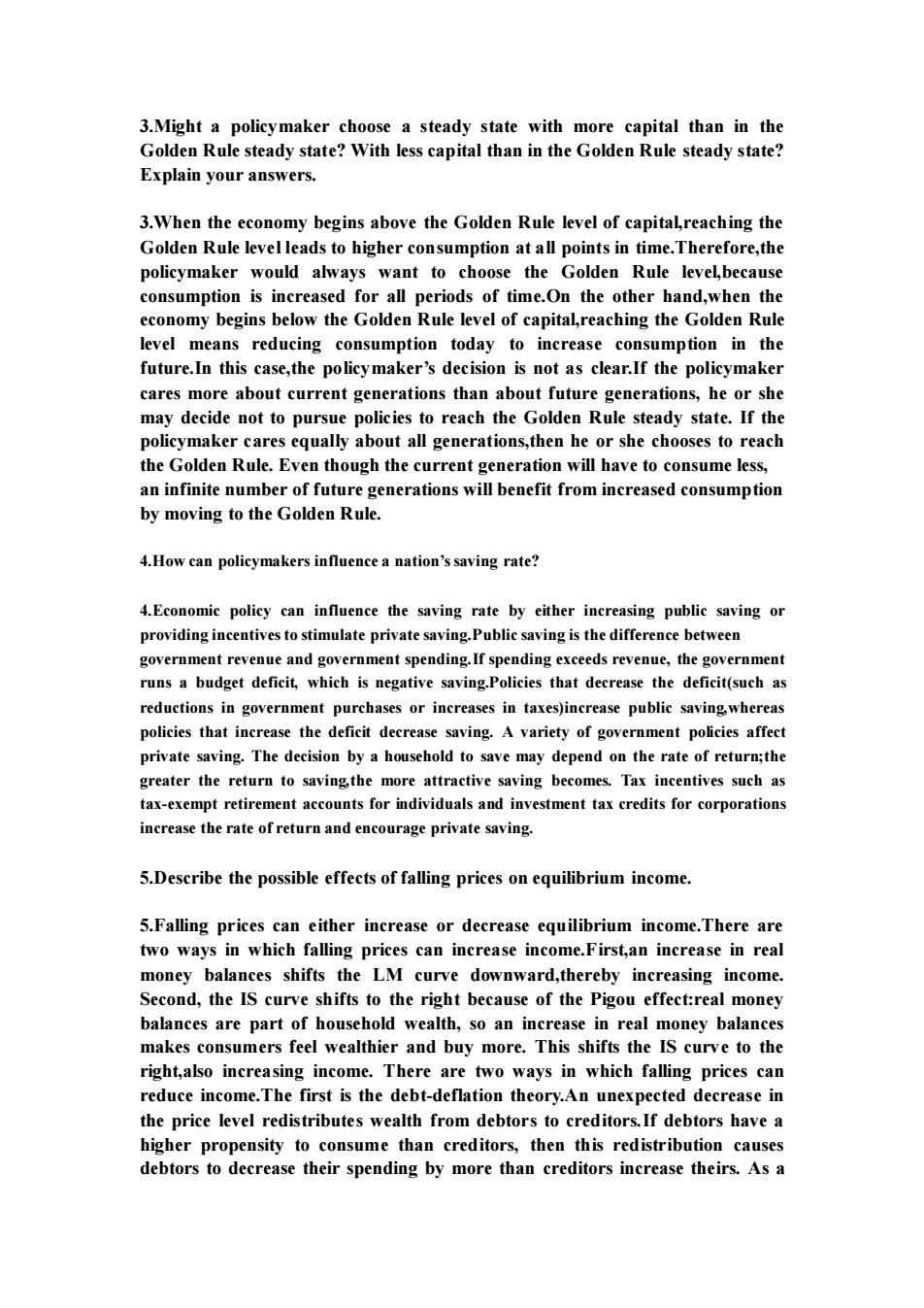正在加载图片...

3.Might a policymaker choose a steady state with more capital than in the Golden Rule steady state?With less capital than in the Golder Rule steady state? Explain your answers. 3.When the economy begins above the golden rule level of capitaLreaching the Golden Rule level leads to higher consumption at all points in time.Therefore,the policymaker ould alw ant to choc ose the Golden Rule level,be cause consumption is rease .0 the othe when th economy begins below the Golden Rule level of capital,reaching the Golden Rul level means reducing consumption today to increase consumption in the future.In this case,the policymaker's decision is not as clear.If the policymaker cares more about current generations than about future generations,he or she decide not to pursu e policies o reach the Golden Rule stea dy state.If the policymaker cares equally about all generations,then he or she chooses to reach the Golden Rule.Even though the current generation will have to consume less, an infinite number of future generations will benefit from increased consumption by moving to the Golden Rule. 4.How can policymakers influence a nation's saving rate? 4.Economic policy can influence the saving rate by either increasing public saving or providing incentives to stimulate private saving.Public saving is the difference between nent spending.If spending exceeds revenue,the government ving policies as the reductions in government purchases or increases in taxes)increase public saving,whereas policies that increase the deficit decrease saving.A variety of government policies affect private saving.The decision by a household to save may depend on the rate of return;the greater the return to saving,the more attractive saving becomes.Tax incentives such as -exempt retir ment accc unts for individuals and inve nt tax credits for corporation increase the rate of return and encourage private saving 5.Describe the possible effects of falling prices on equilibrium income. 5.Falling prices can either increase or decrease equilibrium income.There are two ways in which falling es can increase income.First,an increase in rea money balances shifts the LM curve downward,thereby increasing income Second,the IS curve shifts to the right because of the Pigou effect:real money balances are part of household wealth,so an increase in real money balances makes consume ers feel wealthier and buy more.This shifts the IS curve to the right,also incre ays in which fallin g prices ca reduce income.The first is the debt-deflation theory.An unexpected decrease in the price level redistributes wealth from debtors to creditors.If debtors have a higher propensity to consume than creditors,then this redistribution causes debtors to decrease their spending by more than creditors increase theirs.As a 3.Might a policymaker choose a steady state with more capital than in the Golden Rule steady state? With less capital than in the Golden Rule steady state? Explain your answers. 3.When the economy begins above the Golden Rule level of capital,reaching the Golden Rule level leads to higher consumption at all points in time.Therefore,the policymaker would always want to choose the Golden Rule level,because consumption is increased for all periods of time.On the other hand,when the economy begins below the Golden Rule level of capital,reaching the Golden Rule level means reducing consumption today to increase consumption in the future.In this case,the policymaker’s decision is not as clear.If the policymaker cares more about current generations than about future generations, he or she may decide not to pursue policies to reach the Golden Rule steady state. If the policymaker cares equally about all generations,then he or she chooses to reach the Golden Rule. Even though the current generation will have to consume less, an infinite number of future generations will benefit from increased consumption by moving to the Golden Rule. 4.How can policymakers influence a nation’s saving rate? 4.Economic policy can influence the saving rate by either increasing public saving or providing incentives to stimulate private saving.Public saving is the difference between government revenue and government spending.If spending exceeds revenue, the government runs a budget deficit, which is negative saving.Policies that decrease the deficit(such as reductions in government purchases or increases in taxes)increase public saving,whereas policies that increase the deficit decrease saving. A variety of government policies affect private saving. The decision by a household to save may depend on the rate of return;the greater the return to saving,the more attractive saving becomes. Tax incentives such as tax-exempt retirement accounts for individuals and investment tax credits for corporations increase the rate of return and encourage private saving. 5.Describe the possible effects of falling prices on equilibrium income. 5.Falling prices can either increase or decrease equilibrium income.There are two ways in which falling prices can increase income.First,an increase in real money balances shifts the LM curve downward,thereby increasing income. Second, the IS curve shifts to the right because of the Pigou effect:real money balances are part of household wealth, so an increase in real money balances makes consumers feel wealthier and buy more. This shifts the IS curve to the right,also increasing income. There are two ways in which falling prices can reduce income.The first is the debt-deflation theory.An unexpected decrease in the price level redistributes wealth from debtors to creditors.If debtors have a higher propensity to consume than creditors, then this redistribution causes debtors to decrease their spending by more than creditors increase theirs. As a